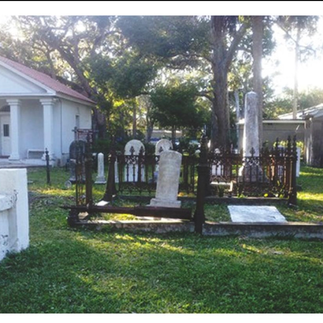The Sacredness of Catholic Cemeteries according to Padre O’Riley.
- Roland Flores
- Nov 7
- 4 min read
Ave María! May Our Lady, Queen of All saints, together with all the Saints and Martyrs, pray for us, and May the souls of all the faithful departed, through the mercy of God, rest in peace. Amen. As we hopefully gather at the cemeteries in prayer the next few days, we should ponder a lesson from a priest of Old Florida.
Who is Father Miguel O'Reilly?
Father O'Reilly was born in Ireland and later left for Spain to pursue the priesthood, as the British suppressed Catholicism in Ireland. Father O’Reilly was ordained in 1778, and was sent to Florida shortly after that. Father O'Reilly was tasked with administering to the Irish and Minorcans in St. Augustine. In 1785, Father O'Reilly bought a residence to be used as his home and with rooms to be a school. In 1793 Father O’Reilly was appointed as the pastor of St. Augustine and in 1795 as the Vicario of Spanish East Florida. In 1797, he helped design and dedicate the new St. Augustine parish church, which is current Cathedral-Basilica of St. Augustine. Among his desire for education, Father O’Reilly abhorred slavery, revolution, and was staunchly loyal to the Spanish crown. In 1812 Father O’Rilley died of natural causes and was buried in the Tolomato Cemetery.
The cemetery controversy.
In 1811, the old Father O'Reilly became involved in a local scandal regarding the Tolomato Cemetery. Originally, the Tolomato Cemetery was an Indian Mission called Nuestra Señora de Guadalupe de Tolomato established in 1573 elsewhere. In 1702 the mission moved to St. Augustine as a response to British invasions. However, after the British occupied Florida in 1763, the Mission was abandoned. In 1784, when Spain returned the Mission Tolomato lands were designated as the Catholic cemetery and the old chapel was restored. This work was probably done by Father O'Reilly but it should be noted there is no record of any ceremony or blessing taking place in 1784. This is because the original mission already had a consecrated cemetery within it.
In July of 1811 Sir Francis P. Fatio died. Fatio was a wealthy protestant plantation owner who came to Florida with the British. His family, now the prominent owners of the New Switzerland Plantatio, wanted to bury Fatio with his wife, Maria Magdalena in Tolomato. However, refused the burial arrangements. When he first read the request, he inquired with Father Crosby, who had been present during Fatio's final hours. Father Crosby admitted that Fatio boldly rejected every occasion of the sacraments and repentance. Fatio died a Protestant with no public display of repentance, unlike his wife who was a Catholic and who had received the last rites. The Fatio family protested and sought help from secular authorities. Spanish Governor Juan Jose de Estrada intervened in the burial issue, viewing the Fatio family as an important force in East Florida, but Father O’Reilly replied that the governor oversaw the political aspects of the colony and the priest's jurisdiction was church matters - including the refusal to bury an enemy of God in a sacred place. Father O'Reilly prevailed and Fatio was buried at his beloved New Switzerland plantation.
Reflection.
Was Father O’Riley right ? Is a Catholic cemetery meant for just Catholics? Some argued that Father O’Riley sinned against the corporal work of mercy to bury the dead. However it seems quite evident what Father O'Reilly's intentions were. In the late Father Henry Sebastian Bowden's "Mementoes of the English Martyrs For Every Day of the Year" we read of a Catholic layman, John Jessup, who was arrested for aiding and harboring a priest. Jessup died in 1587 prisoned by the British.
Jessup, declared a martyr, gave special instructions in his will that his remains should not be buried in a graveyard but as closely as possible to the body of his priestly friend and fellow martyr, Father Pilchard SJ. When his family questioned this decision, Jessup stated that all “consecrated” cemeteries in England had been desecrated “profaned by the bodies of heretics.” He was also sure that the body and blood of martyrs would sanctify the ground he had chosen. It seems like Blessed John Jessup and Father O’Riley have the same mentality. The remains of heretics, and arguably pagans, desecrate a cemetery. But here is the question, why? The answer is quite simple, Catholic cemeteries are sacred. They are consecrated to God for the service of housing His elect. I have yet to visit one Catholic cemetery and not see the grave of a baptized infant. The cemetery is a place meant for saints. What a fitting place to be on the Octave of All Saints. It would be horrible error to place a statue Martin Luther, John Calvin or Mohamed next to St. Peter, St. Francis or St. Gregory. So why would be enshrine the body of someone who publicly refused God’s Grace and place them with those who publicly did not? Tolomato Cemetery was a Catholic cemetery, likely hallowed by the blood of martyrs as many Indians were killed for the faith by the British between 1704-1740 in St. Augustine.
References:
Founding Fathers, 2012, StAugustine.com
Not all roads lead to Tolomato Cemetery, 2013, StAugustine.com.
John Jessop ~ A Catholic's Grave, Mementoes of the English Martyrs and Confessors: For Every Day in the Year.
A Brief History of Tolomato Cemetery



